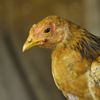In "The Ethics of Artificial Intelligence," Bostrom and Yudkowsky discuss the relevance of subjective rate of time to how we should treat a sentient mind (pp. 11-12):
The article "How fast is the brain?" has a very rough estimation of clock speed in humans.
I'm curious whether the temporal rate of emotion varies not just between AIs and humans but also among animal species. In "Of Mice and Elephants: A Matter of Scale" George Johnson explains:
My guess is that heartbeat speed is not equivalent to subjective clock speed. However, maybe this should slightly increase our expectation for the subjective rate of experience of small mammals relative to large ones.
------
Update from 11 Feb. 2013:
It appears that the firing rate of neurons does vary by species, because firing rates are constrained by thermodynamic properties of brains. In "Thermodynamic constraints on neural dimensions, firing rates,
brain temperature and size," Jan Karbowski presents a theoretical model according to which firing rates are slower in larger mammals. Using empirical cerebral glucose utilization rates, he calculates theoretical firing rates in Table 2 (p. 56):
Theoretical average firing rate by species
−0.15 (Fig. 5C), implying that average activity in larger brains is slower than in smaller brains." I think this -0.15 exponent may have some relation to the same number in his 2007 article, "Global and regional brain metabolic scaling and its functional consequences"?
Caveats:
---
Update from 16 Feb. 2013:
Jonatas Müller and David Pearce left comments when I shared this on my Facebook timeline.
Suppose that an upload could be sentient. If we run the upload program on a faster computer, this will cause the upload, if it is connected to an input device such as a video camera, to perceive the external world as if it had been slowed down. For example, if the upload is running a thousand times faster than the original brain, then the external world will appear to the upload as if it were slowed down by a factor of thousand. Somebody drops a physical coffee mug: The upload observes the mug slowly falling to the ground while the upload finishes reading the morning newspaper and sends off a few emails. One second of objective time corresponds to 17 minutes of subjective time. Objective and subjective duration can thus diverge.
Subjective time is not the same as a subject’s estimate or perception of how fast time flows. Human beings are often mistaken about the flow of time. We may believe that it is one o’clock when it is in fact a quarter past two; or a stimulant drug might cause our thoughts to race, making it seem as though more subjective time has lapsed than is actually the case. These mundane cases involve a distorted time perception rather than a shift in the rate of subjective time. Even in a cocaine‐addled brain, there is probably not a significant change in the speed of basic neurological computations; more likely, the drug is causing such a brain to flicker more rapidly from one thought to another, making it spend less subjective time thinking each of a greater number of distinct thoughts.
The variability of the subjective rate of time is an exotic property of artificial minds that raises novel ethical issues. For example, in cases where the duration of an experience is ethically relevant, should duration be measured in objective or subjective time? If an upload has committed a crime and is sentenced to four years in prison, should this be four objective years—which might correspond to many millennia of subjective time—or should it be four subjective years, which might be over in a couple of days of objective time? If a fast AI and a human are in pain, is it more urgent to alleviate the AI’s pain, on grounds that it experiences a greater subjective duration of pain for each sidereal second that palliation is delayed?
The article "How fast is the brain?" has a very rough estimation of clock speed in humans.
I'm curious whether the temporal rate of emotion varies not just between AIs and humans but also among animal species. In "Of Mice and Elephants: A Matter of Scale" George Johnson explains:
As animals get bigger, from tiny shrew to huge blue whale, pulse rates slow down and life spans stretch out longer, conspiring so that the number of heartbeats during an average stay on Earth tends to be roughly the same, around a billion. A mouse just uses them up more quickly than an elephant.
Mysteriously, these and a large variety of other phenomena change with body size according to a precise mathematical principle called quarter-power scaling. A cat, 100 times more massive than a mouse, lives about 100 to the one-quarter power, or about three times, longer. (To calculate this number take the square root of 100, which is 10 and then take the square root of 10, which is 3.2.) Heartbeat scales to mass to the minus one-quarter power. The cat's heart thus beats a third as fast as a mouse's.
My guess is that heartbeat speed is not equivalent to subjective clock speed. However, maybe this should slightly increase our expectation for the subjective rate of experience of small mammals relative to large ones.
------
Update from 11 Feb. 2013:
It appears that the firing rate of neurons does vary by species, because firing rates are constrained by thermodynamic properties of brains. In "Thermodynamic constraints on neural dimensions, firing rates,
brain temperature and size," Jan Karbowski presents a theoretical model according to which firing rates are slower in larger mammals. Using empirical cerebral glucose utilization rates, he calculates theoretical firing rates in Table 2 (p. 56):
Theoretical average firing rate by species
- Mouse = 6.18 Hz
- Rat = 5.03 Hz
- Rabbit = 4.59 Hz
- Cat = 4.47 Hz
- Macaque = 2.38 Hz
- Baboon = 2.33 Hz
- Human = 1.68 Hz
−0.15 (Fig. 5C), implying that average activity in larger brains is slower than in smaller brains." I think this -0.15 exponent may have some relation to the same number in his 2007 article, "Global and regional brain metabolic scaling and its functional consequences"?
Caveats:
- It seems these estimates are only based on a theory for how firing rates are determined by glucose utilization. It would be great to find empirical estimates of firing rates, because they are directly measurable.
- These numbers are only for mammals. Would exothermic species have different patterns? For example, it seems perhaps implausible to suggest that firing rates for a grasshopper should be much bigger than for a mouse, because the grasshopper's overall metabolism is different.
- The effect size isn't huge between species. Assuming we would use a linear weighting by average firing rate in welfare calculations, a mouse would only get 3.7 times the weight of a human. If the differences are indeed this small across species, then maybe clock speed isn't a high priority in the calculations.
- Is "average neural firing rate" even a good proxy for "perceived rate of subjective experience"??
---
Update from 16 Feb. 2013:
Jonatas Müller and David Pearce left comments when I shared this on my Facebook timeline.



